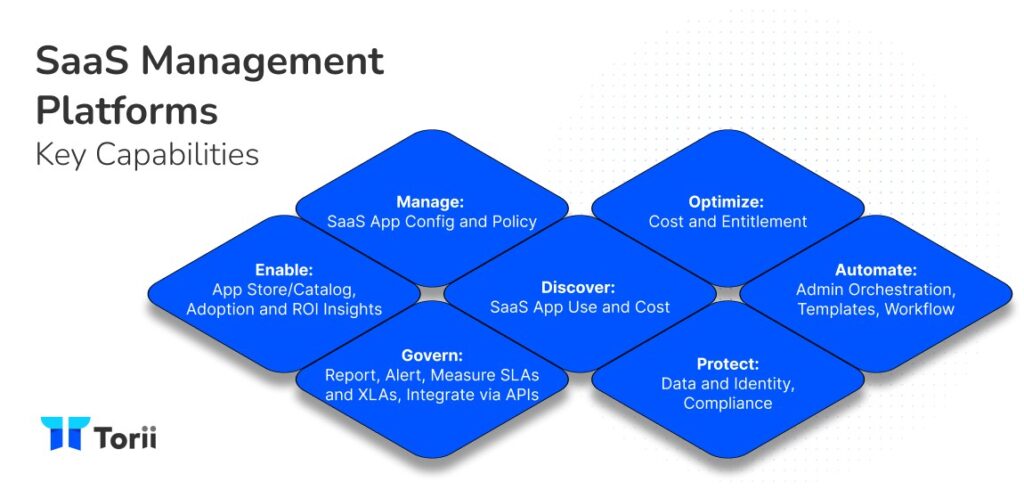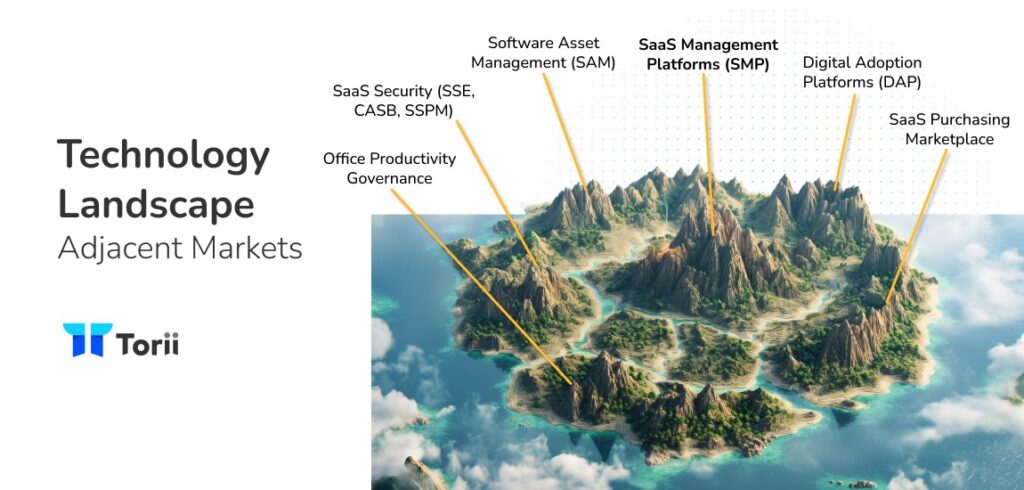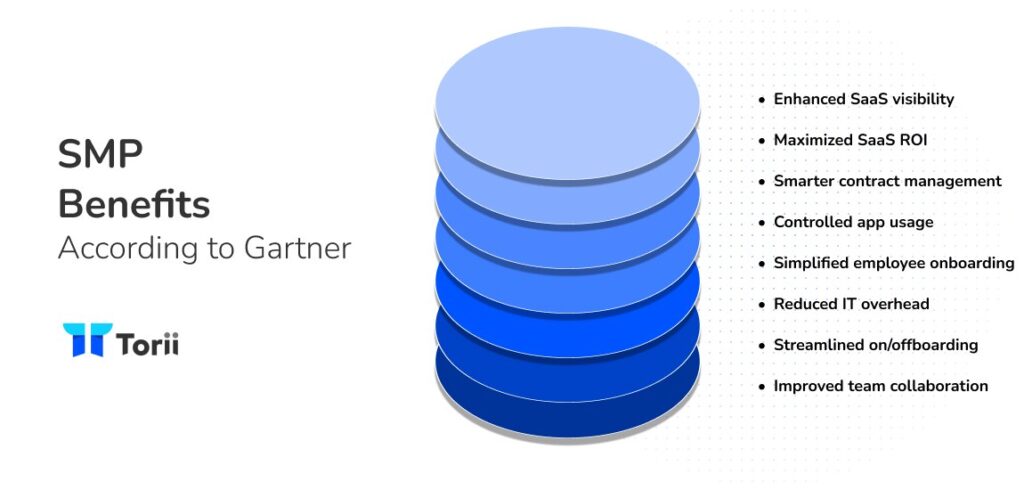Overview of the Gartner® Market Guide for SaaS Management Platforms
The Gartner Market Guide for SaaS Management Platforms is a detailed research document that analyzes the current trends, challenges, and opportunities in managing SaaS applications within business settings. It serves as a resource for IT leaders and decision-makers, guiding them in the effective management of the increasing use of SaaS applications across their organizations.
Significance of SMPs: SMPs play a critical role in supporting organizations in discovering, managing, automating, optimizing, governing, and enabling the efficient and secure use of SaaS applications. The goal is to minimize costs and maximize investments through better management.
Key Takeaways:
Market Maturity: The SMP market as immature and fragmented, which complicates the selection process for IT leaders. This market condition can lead to the adoption of tools that may not fully meet an organization’s needs.
Rapid Growth and Decentralization: Organizations are increasing their SaaS spending by 15-20% annually, maintaining an average of over 125 different SaaS applications, which results in significant sprawl and decentralized ownership.
Risk of Non-Compliance and Security Issues: Without centralized SaaS lifecycle management, organizations are five times more likely to suffer from cyber incidents or data loss due to misconfigurations.
Need for Comprehensive Tools: SMPs are distinct because they provide capabilities to discover, manage, automate, optimize, govern, and enable SaaS applications comprehensively. This is contrasted with other tools that might offer some but not all of these capabilities.
Market Fragmentation and Confusion: The SMP market is not only growing but is also fragmented, leading to confusion among buyers due to overlapping offerings from adjacent market tools like software asset management (SAM) and SaaS security.
Integration and Collaboration: Effective SaaS management requires integration and collaboration across procurement, finance, IT security, and line of business (LOB) to maximize the return on SaaS investments and effectively manage the lifecycle.
Future Trends: According to Gartner, we will see increased demand for SMPs due to the recognition of the risks and costs of unmanaged SaaS environments. It also anticipates market consolidation and increased offerings of managed services.
What is a SaaS Management Platform?

SaaS management platforms (SMPs) are centralized administrative consoles that facilitate the discovery, management, automation, optimization, governance, and enablement of SaaS applications used by employees. These platforms also enhance the protection of identities and data. While SMPs uniquely provide a comprehensive suite of these capabilities, there are other tools, such as software asset management, SaaS security, and office productivity governance, that offer supplementary support.
Complementary Technologies

When integrating SaaS discovery, several adjacent technologies can provide partial capabilities of SaaS management platforms (SMPs):
- SaaS Security: Tools like CASB, SSPM, and SSE focus on discovering, protecting, and restricting access based on risk and policies but do not manage, automate, or optimize SaaS.
- Software Asset Management (SAM): Often marketed as SMPs, SAM tools primarily manage discovery on managed devices and can optimize and govern to an extent, yet they lack comprehensive management, automation, protection, and enablement functionalities.
- SaaS Purchasing Marketplaces: These platforms handle brokerage and negotiation of SaaS contracts, and manage costs and consumption, offering some governance and optimization but lacking full discovery, management, automation, protection, and enablement features.
- Digital Adoption Platforms (DAPs): Designed to optimize how employees adopt applications, including SaaS, DAPs generally offer capabilities in discovery, optimization, governance, and enablement but fall short in management, automation, and protection.
- Office Productivity Governance: Originating from tools for platforms like Google Workspace and Microsoft 365, these focus on integrating SaaS apps for data migration, yet do not fully address comprehensive needs in a multi-SaaS environment.
Organizations are advised against creating custom integrations with these technologies to avoid increased total cost of ownership, instead considering a full SMP for more extensive capabilities.
Major Benefits of SaaS Management Platforms:

According to Gartner, SMPs offer several benefits, such as:
- Enhanced oversight and control over SaaS platforms.
- Increased efficiency in how SaaS investments are used, ensuring optimal utilization of resources and entitlements.
- More effective management of SaaS agreements and renewals, leading to cost savings.
- Reduced use of unapproved SaaS applications through a managed app store that offers authorized options.
- Smoother integration of new employees into existing SaaS systems and easier addition of new SaaS applications to the company’s toolkit.
- Decreased IT workload through the use of automation.
- Improved processes for adding and removing employees from SaaS applications.
- Better cooperation among departments involved in managing the SaaS environment.
Get Started With SaaS Management Today
According to Gartner, “By 2027, 40% of organizations using multiple SaaS applications will centralize management using an SMP, and increase from less than 25% in 2022.”
For today’s cloud-first organizations to succeed, they need to get their SaaS under control. Learn how Torii, the SMP built for IT, can help you go from chaos to management. Get a free trial of Torii today.
Disclaimer:
Gartner is a registered trademark of Gartner, Inc. and/or its affiliates in the U.S. and internationally and is used herein with permission. All rights reserved. These graphics were published by Gartner, Inc. as part of a larger research document and should be evaluated in the context of the entire document.
Gartner does not endorse any vendor, product or service depicted in its research publications, and does not advise technology users to select only those vendors with the highest ratings or other designation. Gartner research publications consist of the opinions of Gartner’s research organization and should not be construed as statements of fact. Gartner disclaims all warranties, expressed or implied, with respect to this research, including any warranties of merchantability or fitness for a particular purpose.
[i] Gartner “Market Guide for SaaS Management Platforms” by Dan Wilson, Jaswant Kalay, Tom Cipolla, Joe Mariano
Published 13 December 2022 – ID G00745874